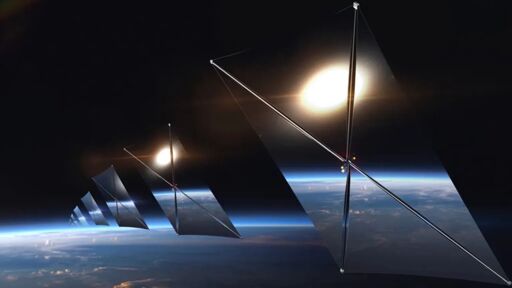California-based startup Reflect Orbital aims to build a swarm of 4,000 giant mirrors in low Earth orbit to “sell sunlight” to customers at night. Experts warn that the mirrors could mess with telescopes, blind stargazers and impact the environment.
Reflect Orbital, which was founded in 2021, has recently taken the first step in a scheme to sell sunlight at night by bouncing solar rays off giant “reflectors” that can redirect the vital resource almost anywhere on our planet. By doing this, the company aims to extend daylight hours in specific locations, thus allowing paying customers to generate solar power, grow crops and replace urban lighting.
But experts say it is a wildly impractical plan that should never get off the ground. What’s more, the resulting light pollution could devastate ground-based astronomy, distract aircraft pilots and even blind stargazers.
This is literally, actually a bond villain plot
Moonraker.
Moonraker was eugenics and nerve gas. Die Another Day was big space mirror.
Capitalism will steal the very foundations of life and sell it to you to make a buck. They will siphon the life force from the earth in order to benefit themselves. I honestly try and look at things dispassionately and put it all in perspective but DAM it’s hard not to be emotional when you see what these fucking stinking pigs are up to on their mountain.
Don’t worry, this type of Space Nuttery is merely a way to extract money from even dumber billionaires.
https://en.wikipedia.org/wiki/Solaren
None of the Space Nuttery fantasies will ever happen.
This exact same technology naturally allows capitalists to force everyone to pay not to have their sunlight blocked during the day.
I mean, the technology certainly has benefits, not in reflecting sunlight onto the dark side of the Earth. Nobody fucking needs that. Instead it should be used to shade a few percent of sunlight in order to control Earth’s warming climate.
But rich people gotta fuck things up. No single entity must ever be allowed to control orbital megastructures.
Rather then launching millions of tons of satellites, maybe the government could try regulating emissions? You know, remove cars, fossil fuel usage, create passenger rail etc? Improve society instead of doing literally the opposite?
Oh absolutely. Regulating emissions and mass carbon capture by replanting forests, then burying them is the only way. Ain’t like it would be even so easy as launching millions of shade satellites. An entire automated zero g manufacturing industry would have to be launched. And while that tickles my scifi nerd fancy, again, we can never allow a scant few humans to gatekeep space resources for themselves. That’s too much wealth and power.
Thought I was in the boring dystopia community instead. I suppose I’ll just continue to hope that this is too impractical to happen or that those responsible aren’t competent enough to make it happen.
What about making our own startup that will make sure to destroy those orbital glasses?
Surface to space missiles seem to be a profitable entreprise
Just launch a ton of ball bearings into orbit, and end space flight for ever. Or at least for the forseeable future.
Edit: Bearing balls, actually. Ball bearings is where the bearing balls are. But we want them in orbit.
It would be easier to have a satellite in orbit that fires a shotgun at them.
You would need some fancy orbital calculations and precise aiming to make sure the shotgun pellets actually intercept the mirrors, and it would take some engineering to make a shotgun that fires the pellets in a narrow enough cone at high enough velocity to be able to get on an intercept course with most satellites, but you could probably fit it on a Starlink-sized payload. The main issue would be bribing a launch provider to send it up there, but once it’s there you could direct it from the ground without it being traceable to you, and you could have it thrust randomly to dodge anti-satellite weaponry until it runs out of shells.
At some point this would create enough space debris that it could trigger Kessler syndrome, with the debris from destroyed satellites hitting other satellites faster than it de-orbits, until all satellites in low earth orbit are reduced to powder that falls down to earth over a couple of years.
Apart from bribing a launch provider to get the satellite up there, you could probably do either of these for under $10 million, most of it R&D. Much cheaper than developing your own surface-to-space missiles.
Let’s be honest: This is military technology camouflaging itself as civilian tech. It totally doesn’t make any sense for the proposed uses, but it totally is worthwhile for military purposes. Jihadist sneaking up onto your base in Bagdadh in the night? Light up the sky! Russian drone attack when it’s dark? Light up the sky! That border to north korea? Eternal sunshine! Your B2 and B52 bombers are on the way? Confuse your enemy by switching the sun on and off! Protect your convois by always have them drive in the night!
Maggie Simpson will sort them out.
Space debris target.
[johnny silverhand noises intensifies]
Futurama did it first.
Yeah, mirrors seem like a huge problem. Why not go with photovoltaics - a decades-old, proven technology, and just beam energy to a ground-based storage facility to be used later?
I know some amount will be lost in conversion and transmission, but you could still have underground facilities in cities providing extended daylight for good reasons, like to help people with seasonal affective disorder, or to grow crops out of season.
In addition to being a moronic idea, this is also physically infeasible as I outlined in excruciating detail in my comment the last time this came up. The takeaway is that this is an investor scam for sure, and the side effects outlined in this article are just a fun (!) and exciting (!) sideshow if these bozos actually do mange to get a single mirror off the ground and deployed. Which they probably won’t.
I disagree they are bozos. I’m actually coming around on the idea. Not the mirror thing of course, but the VC grift using a flashy idea. Millions of dollars and the only thing you make is a slideshow? Brilliant.
It’s tricky business. The idea has to be plausible enough to attract investors, but implausible enough not to get looked at too closely by clever investors. Similarly, you have to drum up enough publicity to get interest, but not enough to get scrutiny.
Get the balance wrong and you get Theranos.
Theranos made a bunch of money for its creators, they just messed up by thinking they could keep lying, when they could have just admitted failure at some point and then moved on to the next grift.
Since then crypto schemes came atone and made it way easier to swindle dumb investors. So the VC grift isn’t as attractive.
I’m gonna start a startup called startup starter and my business plan will be selling business plans to startups that are flashy enough to attract VC money so you can siphon off as much as possible before the business folds.
So you offer Startup Starter™ franchises so I can help startup starters in my area find startup starting ideas?
Sure, just attend their crypto event
I’d like to see that comment if you could link it!
I mean just on the surface of it, this is completely preposterous.
The first thing that comes to mind is you can only cover so much area. 4000 satellites would cover the dog park near me. In the scope of an undertaking like this, it’s a trivial amount of energy they could possibly gather?
That’s the main hurdle.
Re-finding this was a pain in the ass because I didn’t save it. https://lemmy.world/post/19485246/12219336
Editing to add some more meandering. Now this is even longer than the first one.
In addition to surface area limitations, there’s also a pretty obvious line of sight problem in that if your satellite is positioned such that its shiny side is facing the sun, by definition it must be facing the same direction as the Earth’s currently lighted side. The further past the dusk line onto the dark side of the Earth you’re trying to hit the further you have to rotate your mirror until ultimately the surface of it is perpendicular to the incoming sunlight. This is the angle of incidence, in optical terms, and it reduces the effective reflection not only off of the mirror proportionally to the increase in angle (in a roughly geometric manner, I believe) but also where that reflected beam of light hits the ground at its oblique angle. In real terms, it will be impossible to hit any target more than a few degrees past the dusk line with any meaningful amount of energy. Insofar as this harebrained scheme could possibly hit the ground with any amount of energy at all.
The diagram (which is surely not to scale) on these idiots’ website seems to depict a mirror in orbit around the Earth that’s about the size of Massachusetts, which is orbiting at a height that’d put it somewhere in the vicinity of the Van Allen belt, which is also a bad idea (no radio communication for you!) and would result in an orbital period of around 2.5 hours. If so, that means your mirror is whizzing over the surface at something like 14,000 MPH, and you would have some kind of line of sight to it from the ground for maybe 25% of its orbit. So even with the best will in the world and absolutely mathematically perfect rotation control it’ll only be able to remain on a surface target for about 37 minutes at most, most of which would be while it’s uselessly passing through the Earth’s shadow and is reflecting no sunlight at all, and for the remaining handful of minutes with its effective output tapering off to uselessness as it sets over the opposite horizon.
“I’ll just position my mirrors in a geostationary orbit,” says Mr. Clever. “Then I’ll have line of sight to a big chunk of the surface and my satellite won’t move relative to it.”
Well, the further you park your mirrors from the surface, the harder they are to aim. You can’t have it both ways. A geostationary orbit is about 22,000 miles from the surface, a distance from which even the tiniest error in alignment will result in you hitting the wrong target. You can use some middle school trig to calculate this for yourself: At a distance of 22,000 miles, an alignment error of just 0.01 degrees will result in the centerline of your beam missing the target by four miles, which in terrestrial terms is what we refer to as kind of a lot. Maintaining an alignment precision that high especially taking into account gravitational perturbation by the moon, etc., is a rather tall order. To maintain targeting precision within 223 feet, which is probably already unacceptable, you need a constant alignment precision of 0.0001 degrees, and you need to hold it there 100% of the time.
I don’t care how big your rocket is, that’s not happening.
All of this also assumes perfectly flat and 100% reflective surfaces on the mirrors, which never degrades or gets scuffed up or punctured by space debris. Which is also impossible.
To recap:
- You can’t reflect any more energy than strikes the surface area of your mirrors, end of story. The mirrors will be tiny, relative to the size of the Earth, and the Earth is huge, relative to the size of any mirror we can launch.
- The efficacy of your mirrors diminishes geometrically with how far you must angle them relative to the direction of incoming sunlight.
- Most of the time your mirrors will either be in the Earth’s shadow, where they are useless, or over the already illuminated side of the Earth, where they’re pointless. In easily achievable low Earth orbits, their time on target will be very short.
- Positioning the orbits high enough to mitigate either problem will make aiming mathematically impossible, and also magnify any imperfections in focus, which are certain to be vast. That won’t work either.
TL;DR: The whole thing won’t work.
If I had to build such a system, instead of a few satellites with really big mirrors I’d instead have a massive number of small satellites with smaller mirrors. Obviously then any area I’d want to light up, I’d have to hit with a number of the satellites - probably dozens at least or even hundreds of them for decent sized area. That would at least alleviate a few of the problems - aiming would be easier. As satellites move out of range new satellites would be moving in range. Long shadows from the angle of satellite near the edge of their range wouldn’t be as much of a problem as I’d be hitting any spot from a variety of angles. That the satellites would be useless for about 75% of their orbit I could make up for by launching even more satellites.
Of course, it would still be hugely impractical and there would still be major limitations. I’m still not sure how you could manage the aiming - the satellites would have to be continuously adjusting their aim to track their target. Reaction wheels can only do so much and using thrusters you’d burn through propellant like crazy. Launching the required array of satellites would be outrageously expensive and you’d need thousands of them. Eventually something would go wrong - you’d have a collision or one would break up and you’d Kessler yourself right out of business.
Thanks for the write up!
I’m curious how strong an effect atmospheric scattering would have, even after all that
The same a what the sun already has to deal with, really. If your reflection and focus were somehow 100% perfect (impossible, but maybe you could get close) then attenuation from the atmosphere would be the same as what happens to ordinary sunlight over the same surface area, since that also has to pass through the same amount of atmosphere.
Right, but in the daytime, the portion of sunlight that is scattered on the way through the atmosphere to a given spot is partially made up for by sunlight that was scattered to that spot away from other areas, which wouldn’t happen under this scheme.
I’m curious how much scattering occurs - I have no idea how to find or model that.
Oh, yeah. Or, if you’re very close to the horizon and reflecting light that’s already plowed through most of the atmosphere at a very shallow angle before it can hit the mirror satellite, how much attenuation you get from that. Tons, I’m sure.
Yeah this is another rugpull meant to allow the rich to get richer on the money of idiots
“We’re a startup”
“What’s your plan?”
“Giant mirrors in space to control the sunlight that hits the earth’s surface.”
“Wow, sounds incredibly expensive and of dubious technical merit. What are you asking to make this happen?”
“We need whatever money you have in your wallet right now.”
“And the return on investment?”
“Infinity zillion dollars.”
“I guess I’d be a fool not to hand you all my money.”
“Absolutely. Now… that’s a really nice watch. And shoes. We could get you an amazing return if you gave us those, too.”
Ohh, I know of one sack lying piece of shit orange man with a fake tan who could use some concentrated sun rays. And quite a few of his accomplices.
This is the same reason that harvesting solar energy in space and beaming it down is also a stupid fucking idea. It’s politically problematic. Nobody wants anybody to have giant death rays in space, so there’s effectively no way to get the energy down to earth. It looks like we’ll all just have to rely on all the green technologies that already work.
Weaponization or dangerous rays are not among the challenges facing space-based solar.
Contrary to appearances in fiction, most designs propose beam energy densities that are not harmful if human beings were to be inadvertently exposed, such as if a transmitting satellite’s beam were to wander off-course. But the necessarily vast size of the receiving antennas would still require large blocks of land near the end users. The service life of space-based collectors in the face of long-term exposure to the space environment, including degradation from radiation and micrometeoroid damage, could also become a concern for SBSP.







